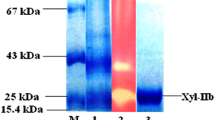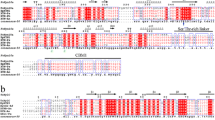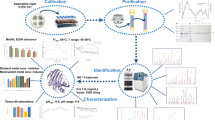Abstract
In our present study, a new Endo-1,4-β-xylanase (EC 3.2.1.8) was isolated, which belongs to glycosyl hydrolase family 10 member. The new enzyme designated as xynA was expressed for biochemical characterization. The xynA xylanase was identified in Paenibacillus sp. EC116. The novel gene had the size of 2673 base pairs, which correspond to 891 amino acid residues. The expressed enzyme has a size of ~100 kDa. The amino acid sequence was similar to that of endo-1,4-beta-xylanase from Paenibacillus sp. FSL R5-192 (ETT36211.1) (96 % identical). The xylanase has an optimal temperature of 40 °C and the pH optimum of 6.0. The specific activity of the xylanase toward birchwood xylan was about 0.69 μmol min−1 mg−1, the V max value of 1.639 μmol mg−1 min−1, and the K m value of 35.1 mg ml−1. The EC116 xylanase was relatively stable up to 60 °C. Xylanase enzymes have numerous industrial applications, which need to meet the specific requirements for each application. We hope that our EC116 xylanase is one of the candidates for commercial applications.








Similar content being viewed by others
References
Ahmad Z, Butt MS, Ahmed A, Riaz M, Sabir SM, Farooq U, Rehman FU (2014) Effect of Aspergillus niger xylanase on dough characteristics and bread quality attributes. J Food Sci Technol 51:2445–2453
Ash C, Priest FG, Collins MD (1993) Molecular identification of rRNA group 3 bacilli (Ash, Farrow, Wallbanks and Collins) using a PCR probe test. Antonie Van Leeuwenhoek 64:253–260
Berrin JG, Juge N (2008) Factors affecting xylanase functionality in the degradation of arabinoxylans. Biotechnol Lett 30:1139–1150
Bradford MM (1976) A rapid and sensitive method for the quantitation of microgram quantities of protein utilizing the principle of protein-dye binding. Anal Biochem 72:248–254
Collins T, Gerday C, Fellar G (2005) Xylanases, xylanase families and extremophilic xylanases. FEMS Microbiol Rev 29:3–23
Cowieson AJ, Hruby M, Pierson EE (2006) Evolving enzyme technology: impact on commercial poultry nutrition. Nutr Res Rev 19:90–103
Deesukon W, Nishimura Y, Harada N, Sakamoto T, Sukhumsirichart W (2011) Purification, characterization and gene cloning of two forms of a thermostable endo-xylanase from Streptomyces sp. SWU10. Process Biochem 46:2255–2262
Dubnau D, Davidoff-Abelson R (1971) Fate of transforming DNA following uptake by competent Bacillus subtilis. I. Formation and properties of the donor recipient complex. J Mol Biol 56:209–221
Fülöp L, Ponyi T (1997) Rapid screening for endo--1,4-glucanase and endo--1,4-mannanase activities and specific measurement using soluble dye-labelled substrates. J Microbiol Methods 29:15–21
Goulart AJ, Carmona EC, Monti R (2005) Partial purification and properties of cellulase-free alkaline xylanase produced by Rhizopus stolonifer in solid-state fermentation. Braz Arch Biol Tech 48:327–333
Gowdhaman D, Manaswini VS, Jayanthi V, Dhanasri M, Jeyalakshmi G, Gunasekar V, Sugumaran KR, Ponnusami V (2014) Xylanase production from Bacillus aerophilus KGJ2 and its application in xylooligosaccharides preparation. Int J Biol Macromol 64:90–98
La Grange DC, Claeyssens M, Pretorius IS, van Zyl WH (2001) Degradation of xylan to D-xylose by recombinant Saccharomyces cerevisiae coexpressing the Aspergillus niger - xylosidase (xlnD) and the Trichoderma reesei xylanase II (xyn2) genes. Appl Environ Microbiol 67:5512–5519
Larson SB, Day J, Barba de la Rosa AP, Keen NT, McPherson A (2003) First crystallographic structure of a xylanase from glycoside hydrolase family 5: implications for catalysis. Biochemistry 42:8411–8422
Lei SP, Lin HC, Wang SS, Callaway J, Wilcox G (1987) Characterization of the Erwinia carotovora pelB gene and its product pectate lyase. J Bacterioal 169:4379–4383
Lisov AV, Belova OV, Andreeva-Kovalevskaya ZI, Budarina ZI, Solonin AA, Vinokurova NG, Leontievsky AA (2014) Recombinant xylanase from Streptomyces coelicolor Ac-738: characterization and the effect on xylan-containing products. World J Microbiol Biotechnol 30:801–808
Luo HY, Yang J, Li J, Shi PJ, Huang HQ, Bai YG, Fan YL, Yao B (2010) Molecular cloning and characterization of the novel acidic xylanase XYLD from Bispora sp. MEY-1 that is homologous to family 30 glycosyl hydrolases. Appl Microbiol Biotechnol 86:1829–1839
Miller GL, Blum R, Glennon WE, Burton AL (1960) Measurement of carboxymethylcellulase activity. Anal Biochem 1:127–132
Ninawe S, Kapoor M, Kuhad RC (2008) Purification and characterization of extracellular xylanase from Streptomyces cyaneus SN32. Bioresour Technol 99:1252–1258
Paës G, Berrin J-G, Beaugrand J (2012) GH11 xylanases: structure/function/properties relationships and applications. Biotechnol Adv 30:564–592
Rajasree KP, Mathew GM, Pandey A, Sukumaran PK (2013) Highly glucose tolerant β-glucosidases from Aspergillus unguis: NII 08123 for enhanced hydrolysis of biomass. J Ind Mirobiol Biotechnol 40:967–975
Subramaniyan S, Prema P (2002) Biotechnology of microbial xylanases: enzymology, molecular biology, and application. Crit Rev Biotechnol 22:33–64
Watanabe M, Inoue H, Inoue B, Yoshimi M, Fujii T, Ishikawa K (2014) Xylanase (GH11) from Acremonium cellulolyticus: homologous expression and characterization. AMB Express 4:27
Acknowledgments
This work was supported by grants from the KRIBB Initiative Program and the Korean Ministry of Education, Science, and Technology (grant number NRF-2011-0023196).
Author information
Authors and Affiliations
Corresponding authors
Electronic supplementary material
Below is the link to the electronic supplementary material. .
Rights and permissions
About this article
Cite this article
Kim, MS., Woo, MH., Chang, YH. et al. Biochemical characterization of a noble xylanase from Paenibacillus sp. EC116. Appl Biol Chem 59, 313–320 (2016). https://doi.org/10.1007/s13765-016-0159-6
Received:
Accepted:
Published:
Issue Date:
DOI: https://doi.org/10.1007/s13765-016-0159-6




